Posts Tagged ‘ice and snow removal’
Thursday, December 1st, 2016
How Much Should it Cost to Have an Ice Dam Removed: Ice Dam Steaming Costs Explained by The Ice Dam Company
Ice Dam Removal: Pricing Vs. Cost
As mentioned in Case Study #05, there is a big difference between price and cost when trying to figure out how much your ice dam removal project will cost. The price is what someone tells you over the phone, normally relating to what they charge per hour for their ice dam removal services. We made a list of the 8 most common factors in determining the cost of ice dam removal in Case Study #05. Here is an examination of one major driver in ice dam removal cost: The depth of the ice dam.
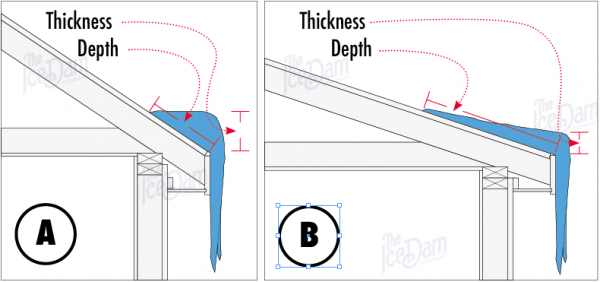
Which takes longer to remove?
Intuition might suggest that thicker ice dams (A) take longer to remove then thinner ice dams (B). Not true. The main factor in the ice dam removal cost is how far up the roof the ice has grown. We refer to this as the ‘depth’ of the ice dam. Deeper ice dams take much longer to remove than those that are thick but shallow.
Estimating the Cost of Ice Dam Removal by Steam
You might think that after having removed thousands of ice dams around the country over the past 25 years we would be able to provide an accurate estimate over the phone as to how long a project might take. Sadly, we can’t. Anyone offering a guaranteed timeframe for ice dam removal projects over the phone is frankly full of it. We know that we can often remove between 10-15 feet of ice dam as measured along an eave every hour after the equipment is set up (C), below left. We know that there are many factors that determine the ultimate length of the ice dam steaming time, as discussed in Case Study #05. One of the main project timeframe drivers is ice dam depth and it can not be known until an experienced eye sees it and that can’t be known until the snow has been removed from the area. Until the ice dam is fully exposed it is impossible to know how long it will take to remove it. In the photos below, the ice dam on the right took three times longer to steam off than the ice dam on the left, even though it was 1/3 the thickness and the roof was a ‘walker’. It’s all about how far up the roof the ice has grown.


To read more Case Studies click here.
Tags: about ice dams, best ice dam removal in minneapolis, best rated ice dam removal contractor, edina ice dam removal, highest rated ice dam removal company in minneapolis, ice and snow removal, ice dam expert, ice dam heat cable, ice dam prevention, Ice dam removal, minneapolis ie dam removal, twin cities ice dam remover
Posted in Ice Dam Prevention, Ice Dam Removal, Ice Dams, Misc., Ice Dams: General Info | Comments Off on Ice Dam Removal Cost
Tuesday, November 15th, 2016
The Fundamental Underlying Cause of Most Ice Dams
We have spent a lot of time discussing the finer points about ice dams over the years. This Case Study is about pulling the focus back to the most global understanding of why ice dams happen.
What Causes Ice Dams
There are over a dozen factors that contribute to the formation of ice dams, all of which have been discussed in previous Case Studies. Fundamentally, only one condition MUST be met in order for ice dams to form: A temperature differential from one area of a roof assembly to another area, with the upper area being above 32° and the lower area being below 32°. See below.
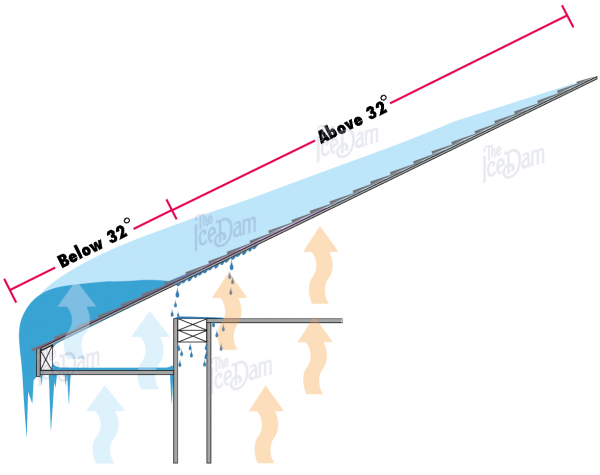
How it Works
This diagram demonstrates the basic concept behind ice dam formation. Snow melts in the area above 32°, water runs down to the area below 32° and refreezes. This cycle continues until an accumulation of ice forms that is large enough to block water from flowing naturally off the roof. The resulting ‘ice dam’ forces water to back up under the roofing materials and into the structure. There are many intersecting variables that cause the phenomenon described here. See below.
List of 7 Contributing Factors to Ice Dam Formation
- A period of outdoor temperatures ranging between 0°-10° at night followed by daytime temperatures between 10°-20°.
- Repeated snow falls that keep the roof loaded with new snow resulting in at least 6″ of coverage at all times.
- Thermal inefficiencies in the home that allow warmth to heat up the roof deck from the underside.
- Homeowner lifestyle that results in excessively heated spaces (More heat equals more roof snow melting).
- Roof pitch: Flatter roof pitches tend to be more affected by problematic ice dams.
- Eave depth: Smaller eaves tend to be more affected by problematic ice dams than deeper eaves.
- Age and construction style of home: Older homes tend to be more affected than newer homes.
To read more Case Studies click here.
Tags: about ice dams, best ice dam removal in minneapolis, best rated ice dam removal contractor, highest rated ice dam removal company in minneapolis, how do I know I have ice dams, how to tell if an ice dam is a problem, ice and snow removal, ice dam heat cable, ice dam prevention, Ice dam removal, ice dam removal jerks, twin cities ice dam remover
Posted in Ice Dams, Misc., Ice Dams: General Info | Comments Off on What Causes Ice Dams
Saturday, October 15th, 2016
How the Distribution of Snow Can Affect the Formation of Ice Dams
Snow and Ice Dams
There is a complex relationship between snow and ice dams. Yes, you need snow to get ice dams. Snow is, after all, the fuel that feeds the formation and growth of ice dams. Furthermore, it is unlikely to get ice dams unless there is an ongoing layer of snow on your roof over a period of time (normally at least 7-10 days). But it takes more than just having snow on your roof to get ice dams. See Ice Dam Company Case Study #23 for a list of contributing factors. One factor that seldom gets discussed is the affect of wind on the formation and severity of ice dams. While this is not a primary factor, it is something worth exploring. This Ice Dam Case Study looks at the affect a thinning snow cover has when seen on a roof slope that also faces the sun. The affect described below is exacerbated by the presence of darker roofing materials as they absorb more solar energy than lighter materials.
Mountains and Roofs Share Something in Common
Any skiers out there? Wind speeds increase near the ridge of a roof just like the top of a mountain. Snow on one side of the ridge is often swept away while remaining in place just on the other side of the peak. This phenomenon can affect both sides of a roof if wind direction changes from day to day, leaving the snow coverage thin or non-existent on the upper few feet of the roof below the ridge.
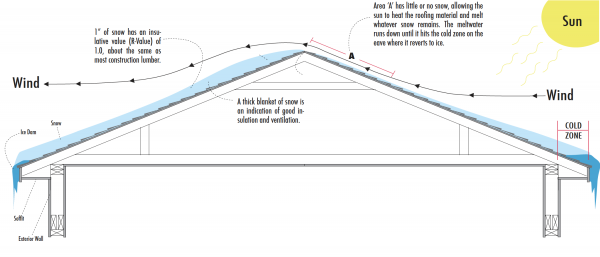
Condensation, The Silent Killer
The lack of an insulating snow blanket can allow heat from the inside of the home to meet cold exterior air in a thinner ‘conduction plane’. When heat hits a thin surface such as a roof decking, where there is a great temperature differential from one side to the other, condensation is also likely. Think of frost on old, single paned windows. The more space there is between the heat and cold, the more room there is for this interaction, greatly reducing the likelihood of condensation. A thick blanket of snow is a perfect insulator for this purpose. It creates more separation between the warmth being lost from the home and the frigid exterior air. Homes with thick snow coverage on their roofs generally seen as more efficient because heat is not escaping through the roofline to reduce the snow through melting.
To read more Case Studies click here.
Tags: about ice dams, best ice dam removal in minneapolis, best rated ice dam removal contractor, highest rated ice dam removal company in minneapolis, how do I know I have ice dams, how to tell if an ice dam is a problem, ice and snow removal, ice dam expert, ice dam removal jerks, ice removal company, minneapolis ie dam removal, steamer
Posted in Ice Dams, Misc., Ice Dams: General Info | Comments Off on Snow Distribution and Ice Dams
Saturday, October 1st, 2016
There is a lot of misinformation out there on the topic of ice dams. Our goal here is to be the single definitive source for all things relating to ice dams. Towards that end, here are some common misconceptions about ice dams, roof snow, roof ice and gutter ice removal.
FACT: Ice dams can occur with virtually no snow on your roof. It’s a question of ice accumulations. It takes very little actual moisture to form ice dams. Even a dusting of snow can create a problem. Of course it is most often the case the thick snow accumulations create ice dams more quickly, but don’t be fooled into complacency because it’s a low snow season. See Case Study #09.
FICTION: Gutters have something to do with ice dams. The truth is gutters have nothing whatsoever to do with ice dams. See Case Study #03 for proof. If your home is prone to ice dams you will get them regardless of whether or not you have gutters. If you have gutters they will fill with ice and provide a foundation for the ice dam above. True. If you don’t have gutters, the ice dam simply builds on the cold edge of the roof. We provide ice dam removal for many homes each year that do not have gutters. In fact, some of our repeat clients have removed their gutters upon the advice of a dumb person only to be shocked that the ice dams came back the season after. Whoops.
FACT: Gutter systems can be damaged by ice. We see it every year. A section of otherwise fine gutter is either on the ground or hanging pathetically off the edge of the roof, filled with ice. Ice weighs about 60 pounds per cubic foot and gutters are not designed to tolerate that sort of load. It’s important to initiate gutter ice removal sooner than later for this reason. See Case Study #11 for common ice dam damage.
FICTION: When it comes to insulation, the more the better. Improperly insulated homes are just as bad as under insulated homes when it comes to ice dams. We have fixed countless bad insulation jobs for this reason. Specifically, we frequently find insulation done in such a way as to inhibit proper ventilation. Moreover, if you don’t address air leakage into the attic or rafter spaces, all the insulation in the world won’t prevent ice dams. See Case Study #04 for details about good eave ventilation.
FACT: You can’t always see ice dams from the ground. It’s true that you can often spot a monster ice dam quite quickly. It’s easy to spot the two foot icicles and the little adjoining glacier on your gutter. The sneaky ones are usually above skylights or in roof pan areas far out of sight. Sometimes ice dams grow up valleys and on top of dormers making it almost impossible to identify from the ground. See Case Study #02 for more information on where ice dams form on residential homes.
FICTION: Salt socks are a smart way to address ice dams. People use pantyhose, old socks and store-bought cloth tubes filled with a variety of ice-melting compounds for removing ice dams. Corrosive substances like rock salt, sodium chloride, calcium chloride, magnesium chloride and more to melt channels through their ice dams. Some compounds are better than others, but all present risks you should keep in mind. Some of the aforementioned chemicals affect the integrity or color of your roof, some are corrosive to the aluminum when gutter ice is removed this way, some are corrosive to valley metal and other flashings, some damage plant life as the water drains below. You are rolling the dice when you go this route so be aware. See Case Study #13 for more information on salt socks (salt in pantyhose).
FACT: Ice should be removed by steam. Here is the skinny. We are roofers and have fixed hundreds of roofs that have been damaged by well-intentioned professionals with hammers, picks and hatchets in their pursuit of removing ice dams to help their clients. The damage we have found caused by the less-than-professional souls is almost funny if it wasn’t so serious. In our years we have seen jobs with picks and hammers where removing ice dams was done successfully. It get’s down to the question of whether you want to take that risk? We strongly advise against the hack-a-teer approach even if it is a little cheaper. Roof Ice and Gutter Ice should always be removed with steam.
FICTION: Ice dams need to be thick to cause a problem. Ice dams as thin as one inch can cause big problems. A good general rule is that the steeper your roof, the thicker the ice dam has to be to cause problems. On lower pitched roofs even a thin ice dam can hurt.
FACT: The leaking caused by ice dams may not show up right away. It would be nice if water stains or mold manifested immediately upon entering your home but it simply does not work that way. Often the water that ice dams push into homes travels around wall and ceiling cavities, trapped by vapor barriers and other materials until it finds the path of least resistance to escape. By the time you see water inside, it’s usually been there for a while, which results in mold and mildew.
To read more Case Studies click here.
Tags: about ice dams, best ice dam removal in minneapolis, best rated ice dam removal contractor, commercial ice removal, edina ice dam removal, edina ice dam steaming, gutter deicing wire, highest rated ice dam removal company in minneapolis, how do I know I have ice dams, ice and snow removal, ice dam expert, ice removal professionals, minneapolis ice dam removal, twin cities ice dam remover
Posted in Ice Dam Prevention, Ice Dam Removal, Ice Dams, Misc., Ice Dams: General Info, Water Damage | Comments Off on 10 Ice Dam Facts: Ice Dam Myths Explored
Sunday, July 3rd, 2016
The Factors that Determine Ice Dam Removal Cost and Pricing
Ice Dam Removal Pricing
Generally speaking, you can expect to pay somewhere between $300 to $600 per hour for ice dam removal with steam. As much as you may not want to hear this, with over 25 years of experience behind us, we can tell you that the primary driver for ice dam pricing is classic supply and demand. Every market will have a different demand for ice dam removal and a different supply of qualified contractors to perform that work. (See Econ101 from your freshman year for further details). Back to the word “qualified”. There are dozens of companies in the Twin Cities market right now who are using ice picks and hammers and axes to remove ice dams. They normally charge less per hour than ice dam steaming contractors. There are also scores of competitors using high temperature pressure washers and calling them steamers (hint: 2 of the top 3 Google results in Minnesota). Yikes. In the Minneapolis market we profit by following the work of the aforementioned “professionals” by repairing the damage they’ve done each winter with pics and pressure washers. It’s hurts to pay for ice dam removal. It’s extra painful to pay for repairing the damage left behind by losers.

Ice Dam Removal Speed
There are many factors that go into determining how long an ice dam takes to remove:
- Roof height (Higher = More difficult)
- Roof pitch (Steeper = More difficult)
- Snow load (More snow = More time)
- Site protections time (Property under the work area needs to be protected to prevent damage from falling ice and snow)
- Ice dam thickness (Thicker = More time)
- Ice dam depth (The further it has grown up the roof, the longer removal takes)
- Outdoor temps (Colder = More difficult)
- Ethics (Lower ethics = More time spent)
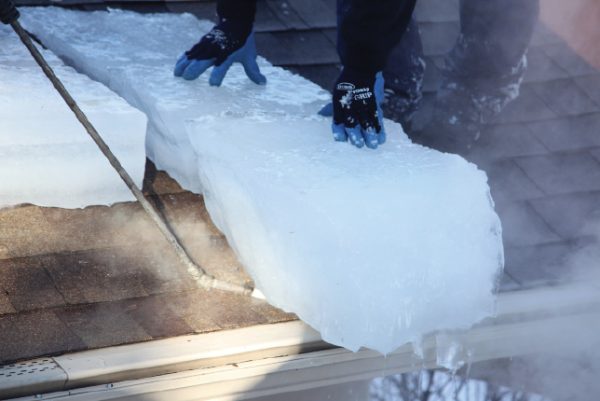
Having two members to the crew is not only important to safety, it is essential for efficiency. One guy cuts and one guy throws the ice chunks.
To Chunk or Not to Chunk
There is a big difference between ice dam removal COST and ice dam removal PRICING. Pricing is what one typically pays per hour for the work to be performed. Cost relates to how long it takes to do the job. In our list of the 8 factors that determine ice dam removal cost, #8 is the most important. That’s what the photos in this case study are meant to illustrate. Ethical ice dam removal guys do it like shown and they use steam, not high temperature pressure washers. It’s called ‘chunking’. The idea is simple. Use the steamer to cut the ice dam into chunks that can be picked up and thrown off the roof. Cutting ice is the part of the job that takes the longest. Add to cutting time, add to the job cost. The alternative is to use the steamer-or pressure washer if you’re totally smarmy-to methodically melt away ALL of the ice from the roof, one square inch at a time. As shown here, one only needs to actually melt about 5-10% of the ice in order to remove the ice dam. Make slots and undercut. It’s that simple. What the less ethical players do is also simple. Melt all of the ice, milk the clock and watch the dollars add up.
To read more Case Studies click here.
Tags: about ice dams, best ice dam removal in minneapolis, best rated ice dam removal contractor, commercial ice removal, edina ice dam removal, edina ice dam steaming, highest rated ice dam removal company in minneapolis, ice and snow removal, ice dam expert, ice dam removal jerks, ice removal company, minneapolis ice dam removal, roof ice steaming, twin cities ice dam remover
Posted in Ice Dam Prevention, Ice Dam Removal, Ice Dams, Misc., Ice Dams: General Info | Comments Off on List of Ice Dam Removal Cost Factors
Monday, December 22nd, 2014
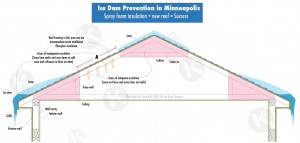
Attic insulation contractor addresses ice dams with new insulation in Edina
Using the words ‘ice dam prevention’ in Minneapolis is a dangerous gamble. It’s true that with certain efforts one can greatly reduce the chances of getting ice dams, it is almost impossible to prevent them altogether. For example, we can do a top quality insulation and ventilation retrofit on a Minneapolis attic only to be thwarted by the fact that the homeowner likes to keep the attic at 90 degrees in the winter. That is a formula for ice dam disaster in Minnesota. There are a number of methods to employ in preventing ice dams (or reducing their severity, in some cases). Here are links to two such approaches used by our sister company, Kuhl’s Contracting, a nationally recognized ice dam prevention company.
Approach to ice dam prevention in Minneapolis #1
Approach to ice dam prevention in Minneapolis #2
Homeowners looking to fix or at least minimize the risk of ice dams in Minnesota are wise to look at the key contributing factors that spawn ice dams. Those are, the weather, insulation, ventilation, air leaks, personal lifestyle and home architecture. We are frequently successful in reducing and/or eliminating ice dams through the use of high performance spray foam insulation systems in combination with enhanced attic ventilation.
Here is another helpful link on the topic of home insulation and ice dam prevention in Minneapolis
Tags: about ice dams, best ice dam removal in minneapolis, best rated ice dam removal contractor, commercial ice removal, construction site ice removal, edina ice dam removal, how to file an insurance claim for an ice dam, ice and snow removal, ice dam expert, ice dam removal jerks, Ice dam Steaming, ice removal company, ice removal from concrete, ice removal professionals, minneapolis ice dam removal, orono ice dam removal, roof ice steaming, signs of an ice dam problem, wayzata ice dam removal
Posted in Ice Dam Prevention, Ice Dams, Misc. | Comments Off on Minneapolis Ice Dam Prevention
Thursday, December 18th, 2014
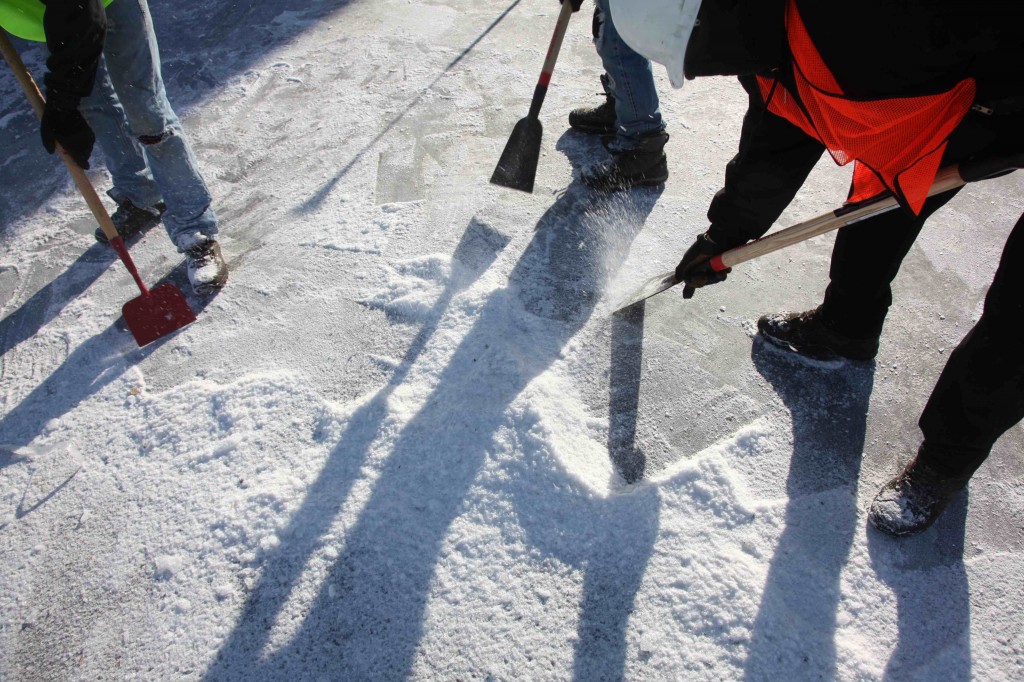
construction site ice removal, commercial ice removal, ice accumulation removal minneapolis, ice dam company
We have been called by property managers and builders to remove ice from a number of odd areas in Minneapolis over the years. Heck, we have even removed ice during the summer around cooling condensers at a chemical plant. While we frequently use our high-end steamers for the removal of ice, sometimes they are simply not appropriate. Such was the case on a recent job at a hotel under construction. A thin layer of ice had built up on the surface of a concrete floor that was perfectly flat…and huge. Using steamers in this application would have possibly resulted in making the problem worse by adding more water to the situation. While our steamers don’t generate much water, any time you melt ice, water is the result. Hence, my concern was that we would create a big mess. I suggested that we go old-school on this challenge. I sent three of my guys out there to hack and chip the ice with shiny, new scrapers. The resulting ice chips were simply blown and swept off the concrete, allowing the project carpenters to follow closely behind and lay out the wall framing without concern. It’s a low tech solution but sometimes that is what’s best.
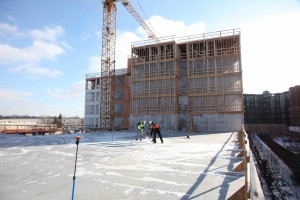
Ice removal minneapolis commercial ice removal from flat surface
Tags: about ice dams, best ice dam removal in minneapolis, best rated ice dam removal contractor, commercial ice removal, construction site ice removal, edina ice dam removal, how to file an insurance claim for an ice dam, ice and snow removal, ice dam expert, ice dam removal jerks, Ice dam Steaming, ice removal company, ice removal from concrete, ice removal professionals, minneapolis ice dam removal, orono ice dam removal, roof ice steaming, signs of an ice dam problem, wayzata ice dam removal
Posted in Ice Dams, Misc. | Comments Off on Commercial ice removal in Minneapolis















